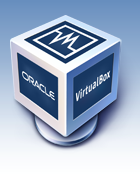VirtualBox
Views
Actions
Namespaces
Variants
Tools
Overview
Developed by Sun Microsystems, now Oracle Corporation, VirtualBox is a popular application that allows for other operating systems (known as Guests) to be installed and run within an existing operating system (known as the Host). This is undertaken through the process of virtualisation, whereby virtual versions of your computer (also referred to as virtual machines or VMs) are created within and draw resources directly from the host system. As such, how fast or powerful a virtual machine may be will depend entirely on the resources available - and allocated - for it to use. The benefits of virtualisation include:
- The fast and easy installation of other operating systems without affecting your existing system (e.g. no need for dual booting and/or preparation in the form of hard disk partitioning or re-sizing)
- Completely safe learning and experimentation with operating systems, as nothing that occurs within a Guest will affect the Host (e.g. the Host operating system can also be installed as a Guest in a virtual machine as a risk-free means of trying out new things), and
- An almost unlimited capacity to install as many additional operating systems as desired...provided space is available on your hard drive to store them!
Installing Virtualbox on Manjaro
Enabling Virtualisation
Before installing VirtualBox, it is absolutely essential to first ensure that virtualization has been enabled in your BIOS. The exact instructions for doing this vary based on your hardware. Please review the manual provided by your computer or motherboard manufacturer for specific instructions.
Install VirtualBox
To install VirtualBox, you need to install the packages virtualbox and linux*-virtualbox-host-modules. The latter must match the version of the kernel you are running.
To install VirtualBox and automatically install the kernel modules for your installed kernels enter the following command in the terminal:
pamac install virtualbox $(pacman -Qsq "^linux" | grep "^linux[0-9]*$" | awk '{print $1"-virtualbox-host-modules"}' ORS=' ')
Once the installation has completed, it will then be necessary to add the VirtualBox Module to your kernel. The easy way is to simply reboot your system. Otherwise, to start using VirtualBox immediately, enter the following command:
sudo vboxreload
Install the Extension Pack
The virtualbox extension pack is available from Arch User Repositoty(AUR). You can install it with:
pamac install virtualbox-ext-oracle
Adding Your Account to the vbox User Group
The final step is to now add your personal user account to the vbox User Group. This is necessary in order to fully access the features provided by VirtualBox, including the ability to use USB devices in a Guest operating system.
The command to add your user-name to the vbox user group is:
sudo gpasswd -a $USER vboxusers
You must logout for the change to take effect.
Advice, Tips, and Tricks
Advice on using Virtualbox effectively, as well as some tips and tricks learned along the way, have been provided for the benefit of new users.
Guest Installation
- Virtualbox can run installation files (ISOs) directly as virtual discs, so there is no need to burn them to an installation medium such as a disc or USB data stick.
- The process to install any Guest operating system - including Manjaro - is exactly the same as if actually installing for real on your computer.
Guest Additions
Guest Additions are special software packages designed to improve the performance and usability of guest operating systems.
They are installed within the Guest operating system itself, and most notably result in enhancing the display resolution, as well as enabling much better control over the mouse. As such, two tell-tale signs that Guest Additions have not been installed in a Guest are that the display will not scale to the size of the display window (i.e. it will be necessary to scroll around to see the whole screen), and the mouse may be quite hard to control.
Guest Display
- It will be necessary to activate the Enable 3D acceleration box in order to allow for some desktop effects (such as transparency) to be shown. This can be undertaken by going into the settings menu, and then selecting the Display section.
Guest Internet Connection
Some users have encountered problems when attempting to connect their virtual machine to the internet using the default VirtualBox settings. Where this is the case, try the following solution
1. Click the Settings Button and then select the Network tab
2. Next to the Attached to heading is a button that states NAT. Click it to reveal a drop down menu and select Bridged Adapter instead.
3. Next to the Name heading is a button whereby you may select how you are currently connected to the internet (e.g. Wlan means Wireless, and Eth0 means Ethernet). Select the appropriate connection type you are currently using.
4. Click the OK button to confirm.
General
- A VirtualBox installation may not automatically detect when USB device has been connected. As such, it may therefore be necessary to click the USB icon located at the bottom of the VirtualBox window in order to select and activate it.
- It is possible to enable the (very useful) ability to copy and paste text between the Guest and Host systems. This is undertaken by clicking Settings button and then going to the General Section.
- Don't be afraid to take risks, to experiment, and to have fun with Guest operating systems. The worst that can happen is that they will have to be re-installed!
Running Manjaro under VirtualBox
For those intending to use Manjaro under VirtualBox, you can install Manjaro as usual.
Once it is installed run the following command to ensure the kernel modules are installed and install the guest utils:
pamac install virtualbox-guest-utils $(pacman -Qsq "^linux" | grep "^linux[0-9]*$" | awk '{print $1"-virtualbox-guest-modules"}' ORS=' ')
See Also
If you have problems installing ask here How to install VirtualBox
